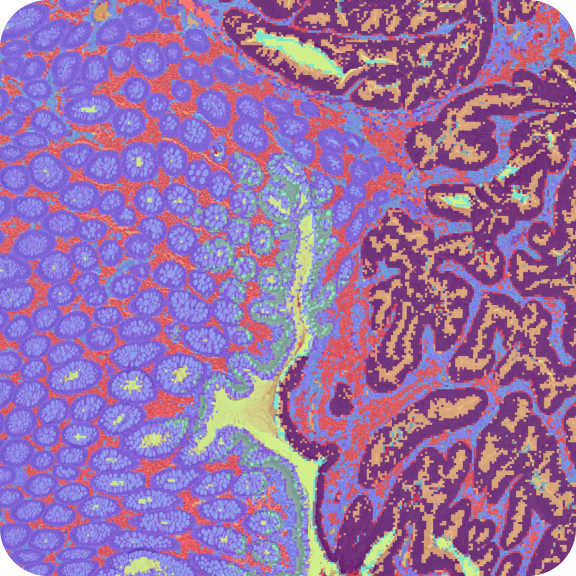Visium HD Spatial Gene Expression Library, Human Breast Cancer (Fresh Frozen), Ultima Sequencing
HD Spatial Gene Expression dataset analyzed using Space Ranger 4.0.1

Learn about Visium analysis
Biomaterials
Fresh frozen human female breast cancer tissue (ductal carcinoma in situ; RIN: 7.7) was obtained from BioIVT.
Sample preparation
A 10 µm section was taken with a cryostat (Epredia CryoStar NX70). Tissue block preparation, sectioning, H&E staining, and imaging followed the Visium HD Fresh Frozen Tissue Preparation Handbook (CG000763).
Imaging
- Image type: H&E
- Microscope: Olympus VS200 Slide Scanner
- Objective magnification: 20X
- Numerical Aperture: 0.8
- ScopeLED light source: VS200 LED, Olympus integrated bright field source
- Camera: iDS VS-264C, Olympus scanner integrated camera
- Exposure: 500 microseconds
Assay workflow
Probe hybridization, probe ligation, slide preparation, probe release, extension, and library construction followed the Visium HD Spatial Gene Expression Reagent Kits User Guide (CG000685).
- Slide serial number: H1-649ZJJX
- Area: A1
- Instrument: Visium CytAssist
- Probe set: Visium Human Transcriptome Probe Set v2.0
Sequencing
Visium HD libraries were amplified to append Ultima-compatible sequences and pooled before sequencing. For additional information regarding making 10x libraries Ultima-compatible, please reach out to technical support at Ultima Genomics.
- Indexing: Libraries were adapted for sequencing on the UG 100™ sequencing platform via conversion PCR using Ultima-specific (UG-tR1 and UG-srR2) indexing primers
- Sequencing instrument: Ultima UG 100™
- Sequencing configuration: sequenced via the UG 100 Solaris™ Flex workflow
- Sequencing depth: 2.02 billion (downsampled)
Analysis
Space Ranger v4.0.1 was used to map FASTQ files to the reference, detect tissue, align the data to the microscope and CytAssist images, and output feature-barcode matrices for further analysis.
Note that the H&E image for this sample shows areas with local freezing artifacts, and the performance of cell segmentation is impacted in these areas. Users facing similar issues with their own samples may consider processing their H&E images through Space Ranger's segmentation pipeline (spaceranger segment) to evaluate performance before running the Visium HD assay.
How to view data
To get started, download Loupe Browser v9.0 to explore the Loupe file, or read more about the other Space Ranger outputs.
This dataset is licensed under the Creative Commons Attribution 4.0 International (CC BY 4.0) license. 10x citation guidelines available here.
